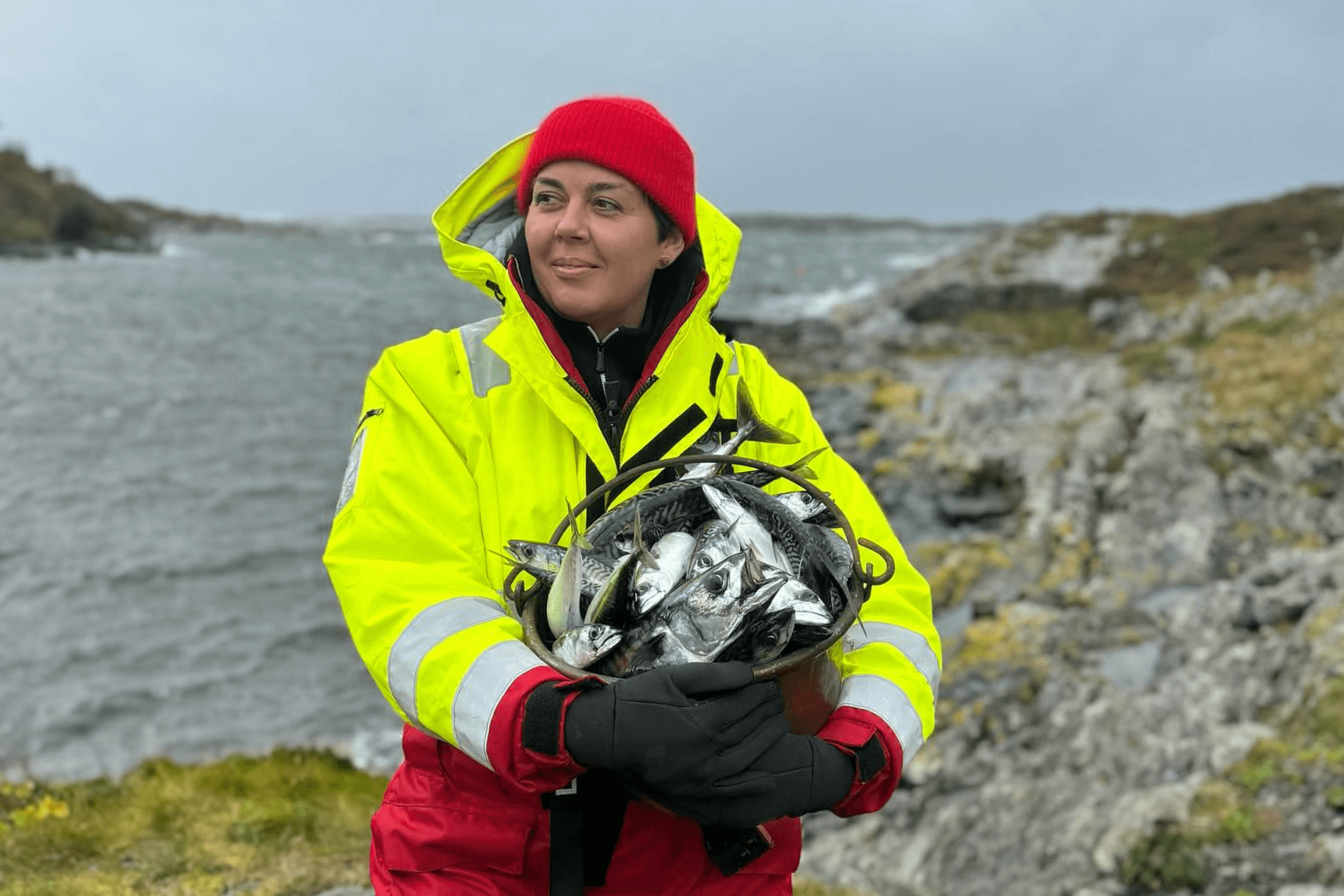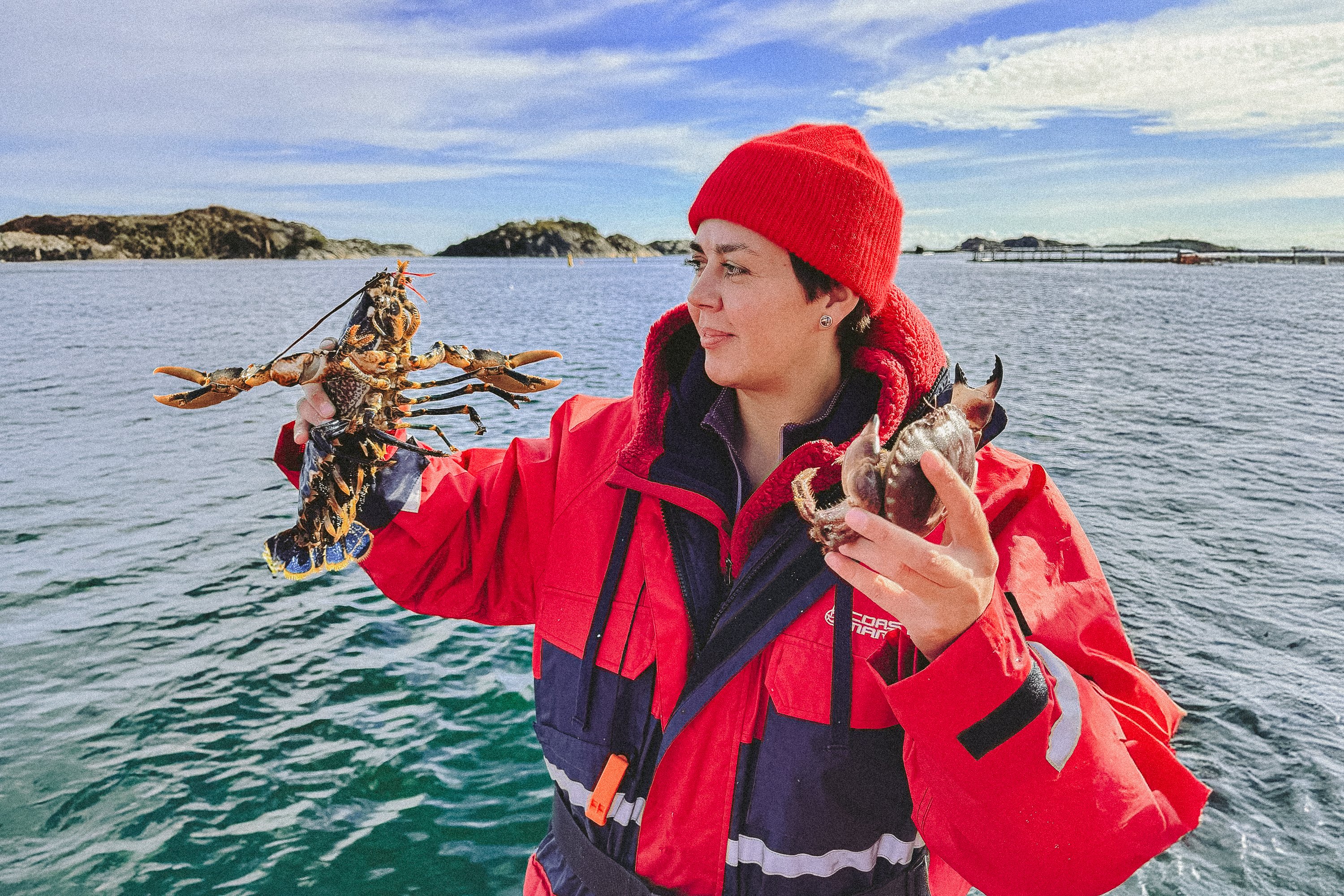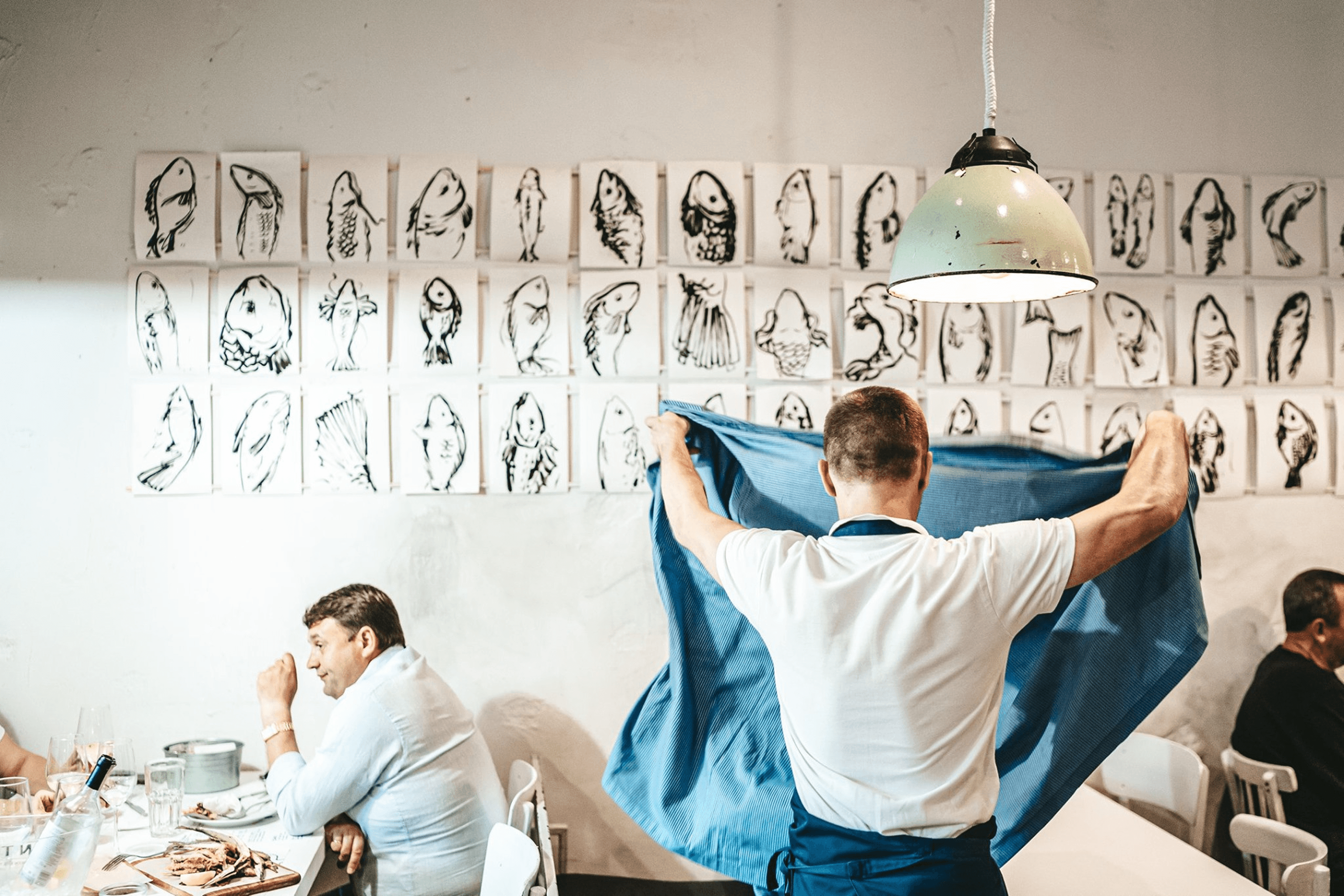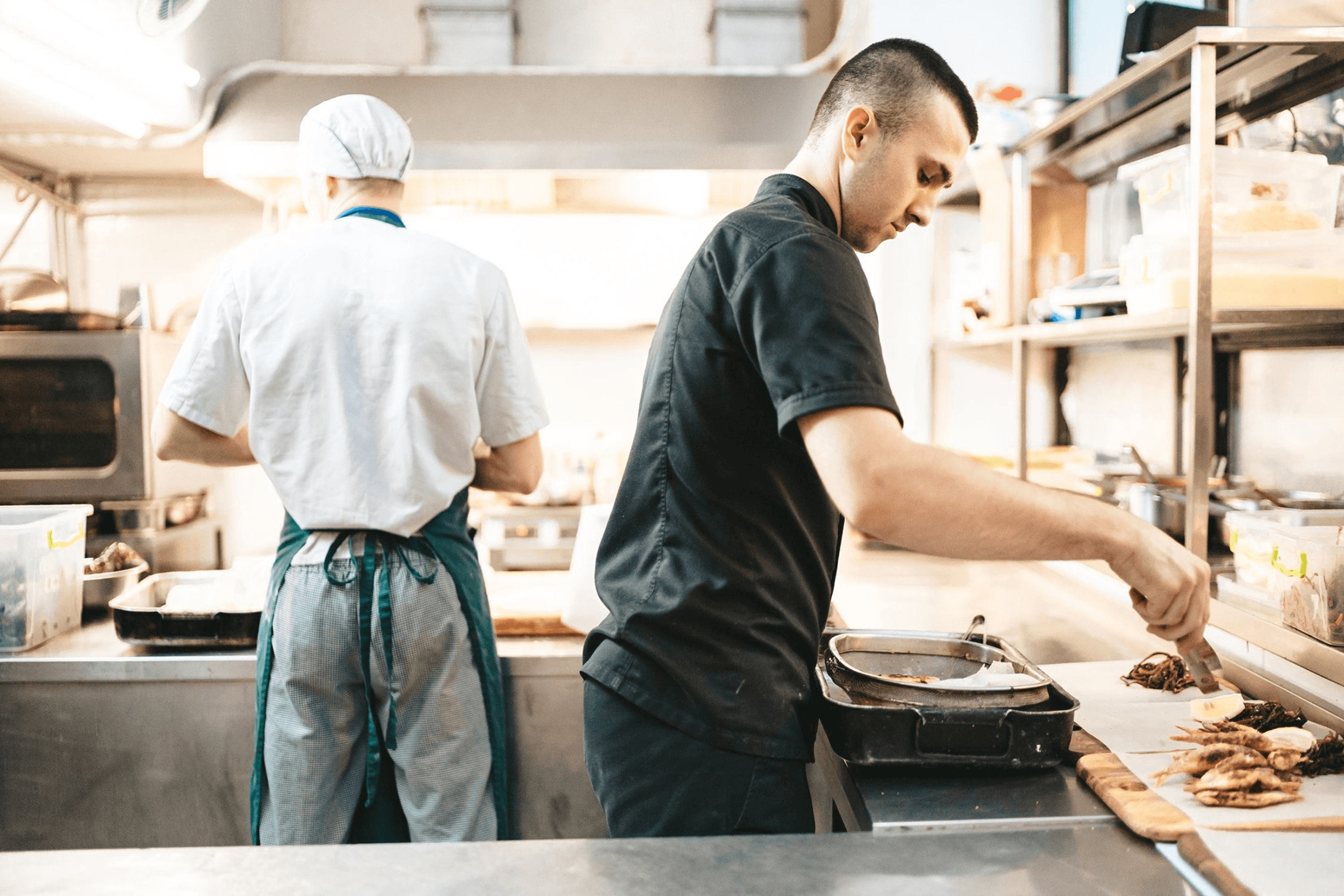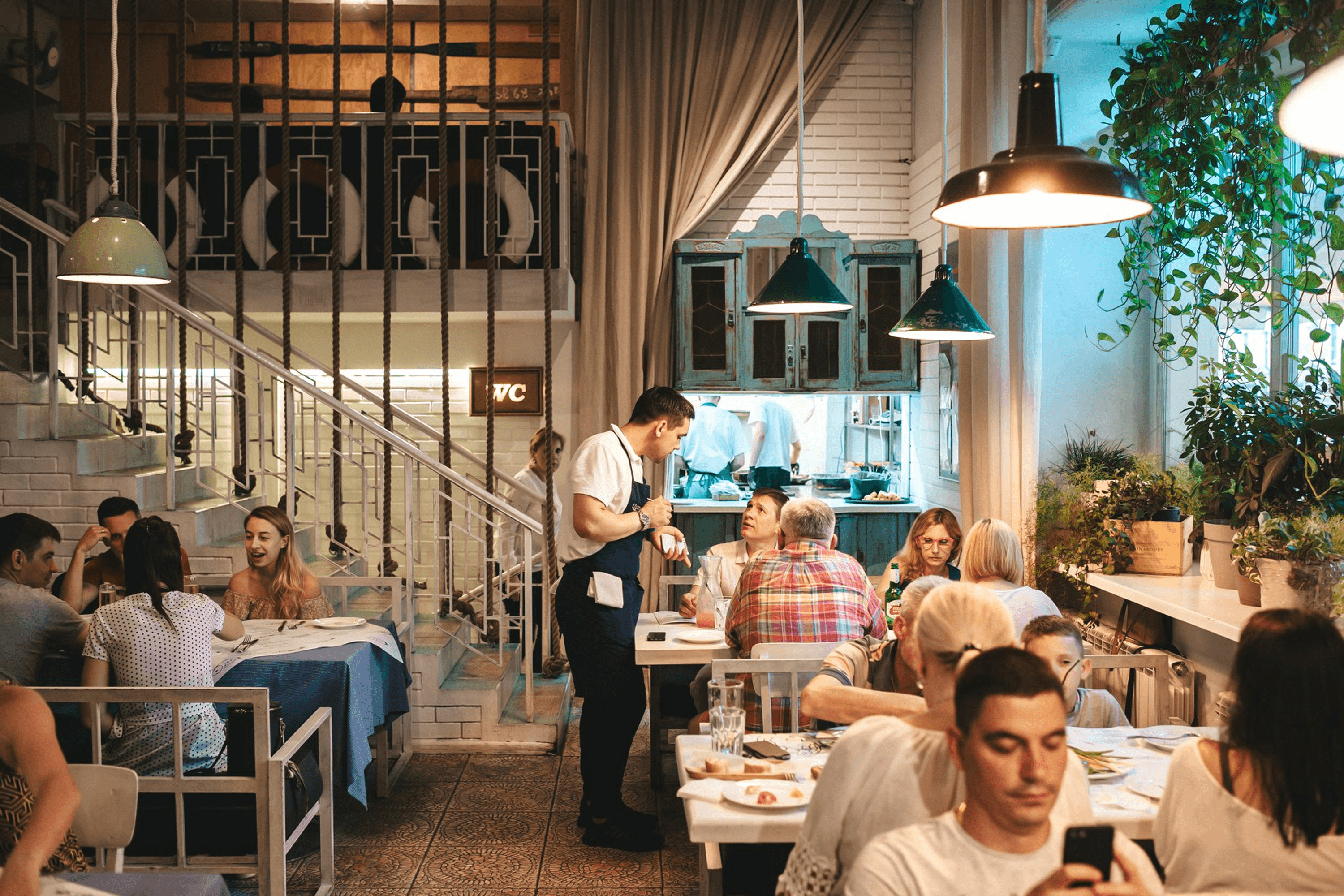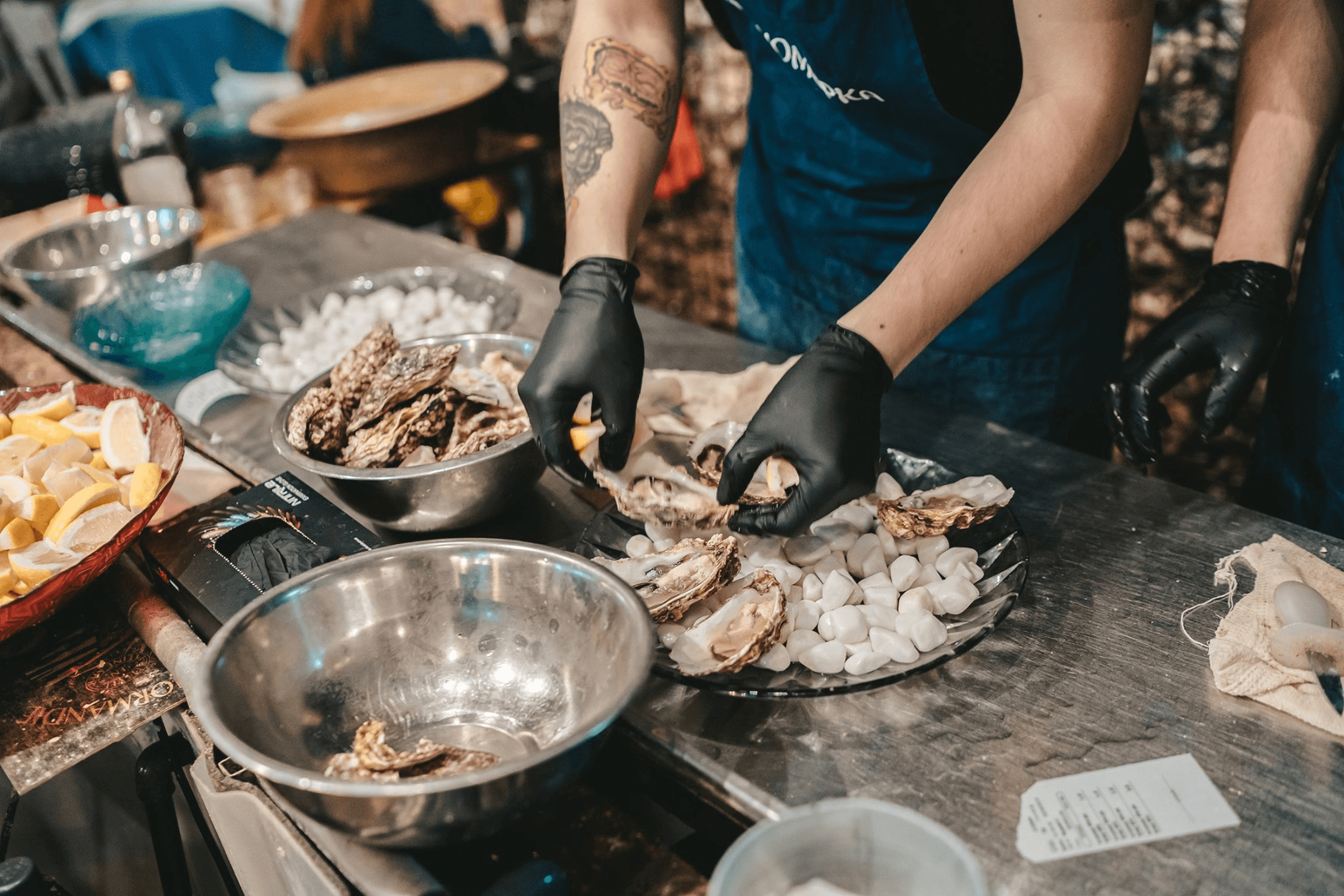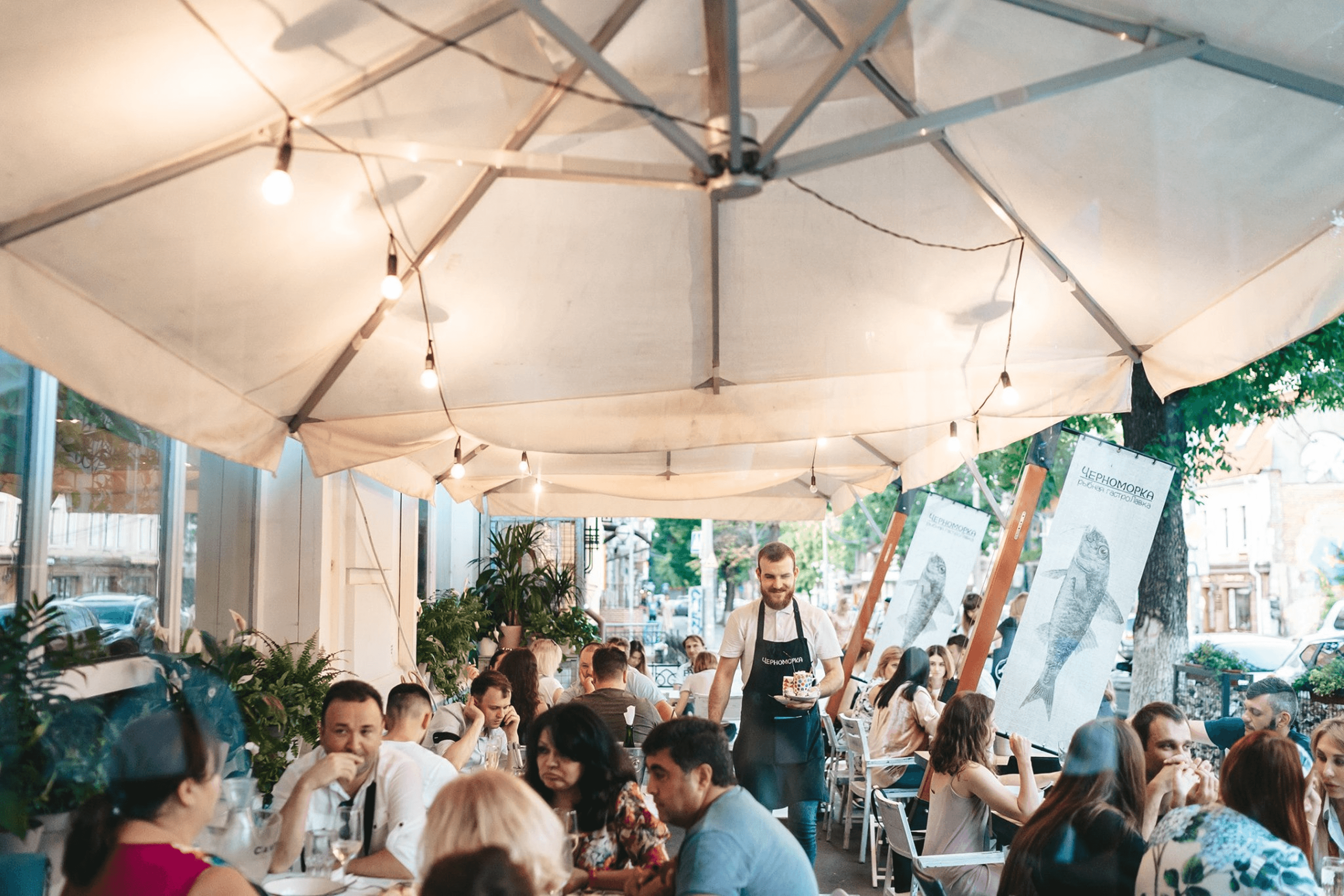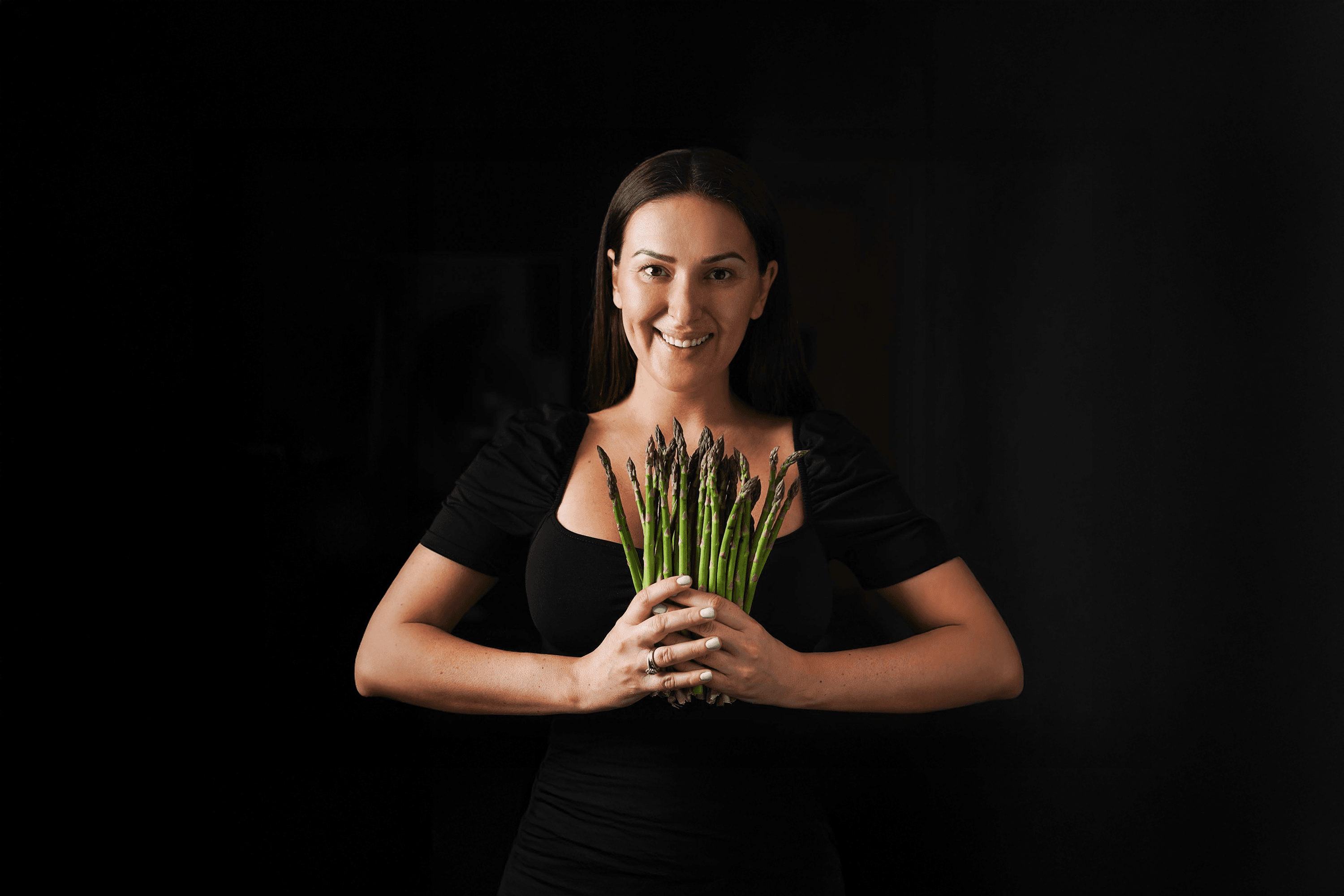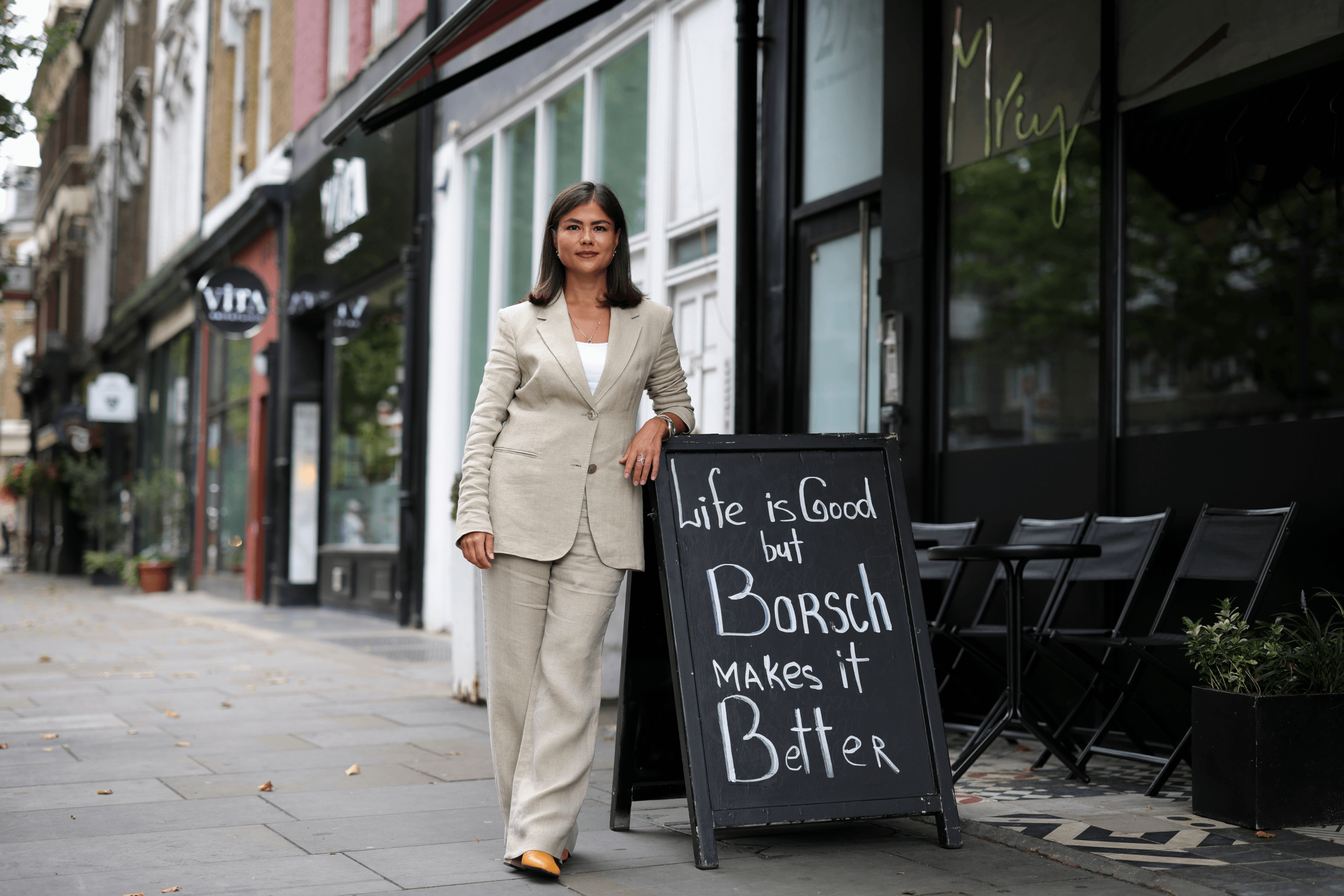Starting with a single Kyiv restaurant in 2013, Crimean native Olha Kopylova and her husband pioneered Black Sea seafood in the Ukrainian capital. Over twelve years, she built a well-known nationwide chain: 29 Chornomorkas and four Anchousnas (Anchovy Houses). Following Russia’s full-scale invasion in February 2022, Kopylova pivoted her strategy, launching her international expansion in Romania and Moldova that April. The current pace is astounding: as the Chornomorka chain operates in seven countries by 2025, Kopylova literally lives in her car to secure premises, planning a new European opening every 2-3 weeks.
Yellow Blue Business Platform (YBBP) journalist Sofiia Korotunenko spoke with Kopylova in Moldova, where the restaurateur was managing the launch of Dom 1921 (House 1921)—an establishment that has become hugely popular in Chișinău thanks to its vintage historic mansion and unique concept where visitors feel as if they’ve come to visit relatives. We discussed the specifics of the restaurant business outside of Ukraine, how Chornomorkas differ in various countries, and the new format projects that Kopylova is personally involved in.
How did you plan to expand the Chornomorka restaurant chain in 2022? And to what extent did Russia’s full-scale invasion in February 2022 affect those plans?
From February to May 2022, we were supposed to open a new location every week. Due to the invasion, all construction projects paused. Ultimately, we opened all the projects we planned, but not at the same speed. The first was Chornomorka in Kamianets-Podilskyi [which we opened in June 2022], followed by Chornomorka in Bucha [in July 2022].
Now in Ukraine, Chornomorkas simply don’t fit the market; we already have quite a few of them. Now [in 2025], we plan to open a new place in Europe every 2-3 weeks.
Your first Chornomorkas abroad—in Moldova and Romania—opened just two months after the full-scale invasion began. But you closed them within half a year. What problems did you face? And how did this experience affect your foreign expansion strategy?
We had two projects running simultaneously. We opened the first one in Chișinău on May 6, and the second one in Constanța on May 14. In Chișinău, after a month of work, the partner [with whom we opened and who managed Chornomorka] left us. He simply turned off the video surveillance cameras there and took away our access to the accounting system [i.e., the restaurant’s operating software]. We lost contact with the team. This happened because the establishment had good earnings and high results, so the partner decided to take the business for himself.
In Romania, in Constanța, winter hit. That city is similar to the Ukrainian Chornomorsk—people simply don’t go out [to establishments] in winter. At the beginning of the full-scale war, Constanța was filled with residents of Odesa. We had huge queues, a lot of Ukrainians. It was even difficult to handle. Then they went back to Ukraine, and Romanians don’t walk the streets or visit Constanța’s restaurants in the winter.
We realized we had to choose locations more carefully for opening. Back then, we just wanted to do something quickly. And these two cases were like a first pancake that didn’t work out.
You currently have restaurants operating in six European countries: Poland, Moldova, Slovakia, the Czech Republic, Austria, and Lithuania. How many establishments do you have and how do you manage them?
It varies greatly. There are franchises, projects managed by our team, and projects with partners. Currently, we have five establishments in Moldova. These are not only Chornomorka but also [the oyster farm] Oysters&Geese, the goat town Kozy (Goats), [our first] Georgian restaurant Chikapuyla, and the new sensational project in Chișinău, Dom 1921 (House 1921).
In the Czech Republic, there is currently one establishment, but we are always looking for new premises. In August 2025, we opened a Chornomorka in Vilnius. Five projects are currently operating in Poland, with several more in the works. Two establishments are already working in Slovakia, and a third is opening now in Košice. Next, we are launching projects in Cyprus, Budapest, Bucharest, Sofia, and Riga. Work is in full swing.
When looking for premises, do you try to take an existing establishment where you can change something, or do you build a restaurant from scratch?
It varies greatly. Sometimes it’s from scratch, sometimes we buy a ready-made restaurant. But we try to look for premises that don’t require major renovations. A ready-made restaurant space is a great find for us, as it significantly reduces investment.
When opening an establishment abroad, who do you primarily target—Ukrainians who already know the brand, or locals?
No, we are no longer targeting Ukrainians, as there are far fewer of them in Europe. Every country is unique, and the same format we open in Ukraine is not suitable there. Europeans won’t accept it—and the establishment will be empty.
We focus on the local population, adapting the menu and presentation. We carefully study the rules of the country or city so that locals will visit us.
Can you give an example of how the habits of Ukrainians and foreigners differ?
[Foreigners] have a culture of ordering delivery and eating at home. While in Ukraine we have up to 10% of such orders, in Cyprus, delivery accounts for about 40% of any restaurant’s turnover. In the Czech Republic, it’s about 30% of turnover. It’s a completely different culture. They don’t go shopping; they order food. This fundamentally changes our work and the menu—it must include dishes that are convenient to package. The restaurant must also have a place to pack orders and the appropriate equipment.
The number of people who eat out at least once a week also differs. In Ukraine, this is approximately 10-20% of the population. I don’t know the exact data, but in Europe, this percentage is noticeably higher. In Vilnius (population only 600,000), more people visit us than in Kyiv (over 3.6 million residents). This is due to a different economic situation.
[Preferences differ in various countries: ] in Vilnius, people like forshmak, red mullet (barabulia), and fish soup, while in Austria, forshmak is never ordered, so we simply remove it [from the menu].
How do you present Chornomorka abroad: as a Ukrainian brand or as a local one? And do you promote local Ukrainian dishes, or do you experiment with local cuisines?
If we live in Ukraine, sometimes we think everyone knows our situation. But when you are in another country, you see that people are busy with their own affairs, eating their own food, living their own lives. They certainly care about Ukrainians, but they don’t center their whole lives around it.
Our task is not to feed them Ukrainian cuisine, but to feed them Black Sea fish. And the Black Sea is not just Ukraine. We are currently planning to organize a [charitable] mission to clean the Black Sea of plastic and garbage. Also, [as part of this project] we will plant oyster reefs so that the sea cleanses itself and provides us with fish. We are more tied to this than to Ukrainian identity and national cuisine.
What is the main thing for you when opening in a new country?
Probably to offer something that isn’t already there. This means a large assortment of oysters, fish, and other seafood, in combination with affordable prices. We don’t choose a country close to the sea where they have their own fish restaurants at every turn. We choose countries where we can offer something new.
How strong is the competition in the countries where your establishments operate?
Every restaurant is competition. Both when we started and now, we stick to the policy that it’s better to focus on our own business and continuously improve our service and food every day, rather than going around and checking on others. It’s clear that there is competition—any place where a person can eat. But if you try to ensure your food is tastier and of higher quality, you probably won’t have to look at what others are doing.
How does the average check differ in various countries?
In Austria, it’s the highest—$47–52. The lowest is in Ukraine, approximately $17. Even in Moldova, it’s higher—$23–30. Abroad, we are still cheaper than other restaurants; our prices are considered democratic. It’s simply a different standard of living there.
In Ukraine, you offered democratic prices thanks to your own fishing operation’s catch in the Odesa region. What’s the situation now? Can you fish for seafood in the Black Sea during the full-scale war?
A missile hit our fishing operation [in 2022]. Fishing is currently forbidden in the [Ukrainian waters of the] Black Sea and will continue to be for some time after the war while the sea is being cleared of mines. We are currently buying an oyster farm in France and a farm in Croatia for catching wild fish and cultivating mussels and [fish like] sea bass and sea bream. We bring Black Sea fish from Bulgaria, Romania, Georgia, and Turkey.
In 2022, you said that establishments abroad would operate on a self-service system. Have you implemented it?
Yes, in all European projects, guests pour their own fish soup, cut their own bread, and open their own oysters. This isn’t the case in Ukraine; we have a need for a different kind of service. In Moldova, our new project, Dom 1921 (House 1921), opened [in August 2025]. It’s a residential house, and we only give guests a tour. After that, people choose their own dishes from the food spread, serve themselves, and cut the bread.
Can you tell us more about this project, Dom 1921?
This is a completely new dining format that’s currently at its peak in Moldova. There’s a frenzy right now—if you haven’t been to the House, you’re out of touch. It consists of two mansions: one built in 1921, the other before 1900. They share a courtyard where the goat Vanessa and chickens roam. We barely changed anything in the houses, only arranged the furniture: tables, chairs, and cabinets with antique dishes.
[When guests arrive], they ring the doorbell. We open for them and give them a tour of the house, explaining where everything is located. They feel like they’re coming to visit, often bringing gifts, such as dinner sets.
We use the former homeowner’s office as the “accountant’s room” [where guests pay the bill]. We don’t have waiters; instead, we have “relatives” (staff who assist guests). We involve guests in household chores—they hang up the laundry, set the table. There is a market in the yard where you can take fruits and vegetables and cut your own salad.
Our processes are not yet fully established. [After the opening] I came there for two days but ended up spending two weeks [at Dom]: cleaning and washing dishes, driving for bread, and managing all other aspects when the team couldn’t keep up. We didn’t plan for guests to cut their own bread: we were physically running out of time and suggested they do it. And this became part of the concept.
In November, the second house, built before 1900, will open to guests. According to our legend, this is the house of the family’s grandmother. In total, we can seat 90 people in the two houses and another 130 in the yard.
Does Dom 1921 also focus on seafood, like Chornomorkas?
No, there is a fish Thursday, but the main menu is home-cooked food prepared by a mother or grandmother. For example, cutlets with potatoes, buckwheat with liver, and various soups. We prepare lunch and dinner, and the menu changes daily. There is no [classic] menu, but we have personalized letters describing the rules of the establishment. Tea time is scheduled for 8:30 PM: we treat guests to herbal tea, bagels, cookies, and candies.
How many visitors does Dom 1921 have?
We have never encountered such a frenzy. All the city’s bloggers are talking about us; everyone considers it their duty to come. Even in Instagram posts, they write: “I finally came to Dom 1921”. It’s like a new iPhone that everyone wants.
On weekends, we have up to 250 tags in Instagram stories [from users], and on weekdays—100–150 tags. We have never had this before; usually, it’s 10–20, sometimes 50 tags a day. This is a record. We have high hopes for this project and plan to enter other countries with it.
In which countries will you open such establishments?
Austria, Germany, and the Scandinavian countries are off the table because they already have enough such heritage-focused establishments. But in post-Soviet/Eastern European states like Moldova, Kazakhstan, Bulgaria, Lithuania, Latvia, where [historic buildings] were destroyed and urban modernization took place, there are no such establishments. Moreover, the culture of visiting others is more common [in these countries]. Therefore, we plan to expand in this direction.
You have several other establishments operating in Moldova that differ from Chornomorkas. These are Oysters&Geese, the Georgian restaurant with a fish focus Chikapuyla, and the goat town Kozy. Is it harder to launch such projects?
No. Moreover, new projects excite me more. The team knows perfectly well how to open a Chornomorka, and my attention is only needed if something goes wrong. For example, if people stop coming or something is not tasty.
Chikapuyla is now one of the most popular establishments in Moldova. Dom 1921 is currently experiencing a frenzy. The goat town Kozy and Oysters&Geese also caused a stir when we opened them [in 2022 and 2024]. [Now] they are operating steadily. No one in Moldova has opened so many projects in a row over the past three years. It’s a very small country, and this is astonishing for them.
In your opinion, why is there such a frenzy surrounding these establishments?
These are projects that did not exist before. For example, establishments like Dom 1921, where you do everything yourself. I don’t even know how we managed it. Initially, we planned a Georgian house there, but then everything changed along the way. This often happens with us: when there is a feeling that the project should be different as then guests will like it more, we quickly change it. We realized that in Dom 1921, it was better not to be tied to Georgia and [instead] focus on the historical part and the format where guests can feel at home.
Due to the war, you moved the goats from your Kozy Ta Matrosy (Goats and Sailors) establishment to Moldova and opened the Kozy establishment with them in August 2022. Do you plan to open such goat towns in other countries?
It’s currently a tourist magnet in Moldova; many foreigners visit us. There were requests for such an establishment in Romania, but goat towns are not currently a priority. We are constantly busy, always opening something new. It’s not a restaurant, and our team is more focused on opening restaurants.
How big is your team?
I don’t know; it’s difficult to keep an exact count. Two new projects opened in August. That’s approximately a hundred more people on the team. We don’t have a culture of counting and boasting about the number of staff. We still can’t even count the projects because they are constantly being added. We focus on sales and foot traffic.
Can you give an example of your best performance indicators?
When we opened the goat town in 2022, we had a huge queue on the first day. We converted everything into hryvnias back then, and on the first day, our total sales were 1.5 million hryvnias. We didn’t know how to count that money. That’s one of the most memorable moments—we were scrambling to count all the cash.
What are your closest goals for foreign expansion?
There are no specific goals. There is a lot of work. I don’t even know how many establishments are currently in the opening stage. Among the priorities are launching a program to clean the Black Sea of plastic. Another is structuring the team: many people are now joining us in managerial positions from Europe and Ukraine to effectively manage all processes.
In January, you mentioned investing about $120,000 in oyster vending machines that you wanted to place in shopping and business centers, at gas stations, and at train stations. What is the status of this project now?
We are modernizing the machine. It’s very “clunky”: to load oysters, you have to climb a ladder and stop all processes. And it doesn’t fit into shopping centers; the height doesn’t meet the standards. It’s currently being redesigned into a more convenient format with a different filling system. This will take some time.
Given your experience with foreign expansion, what advice would you give to Ukrainian entrepreneurs?
Just take action and go. Try it one step at a time—and everything will work out. Don’t be afraid. Eyes are afraid, but hands do the work.
